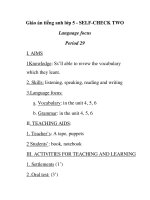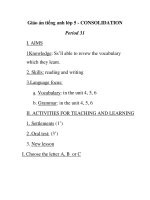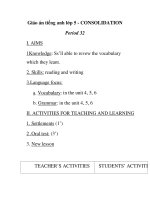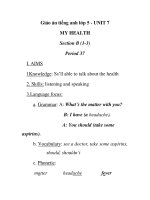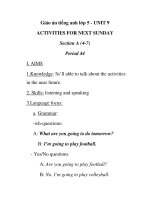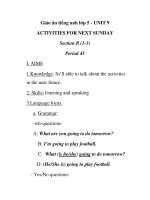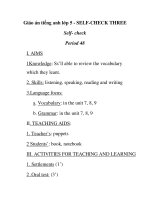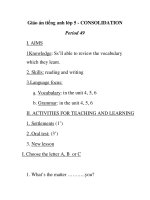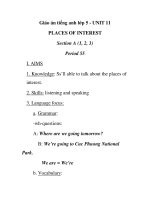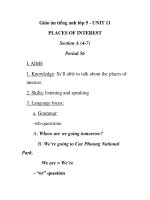- Trang chủ >>
- Luật >>
- Luật thương mại
GIAO AN TIẾNG ANH LỚP 5 TUẦN 03
Bạn đang xem bản rút gọn của tài liệu. Xem và tải ngay bản đầy đủ của tài liệu tại đây (180.7 KB, 10 trang )
<span class='text_page_counter'>(1)</span><div class='page_container' data-page=1>
<i>Date of preparing: 17/9/2020 WEEK 3 - Period 9 </i>
<b>UNIT 2: I ALWAYS GET UP EARLY. HOW ABOUT YOU? </b>
<b>Lesson 2: Part 1+2+ 3</b>
<b>I. </b>
<b> OBJECTIVES</b>
<i><b>1. Knowledge: After the lesson students can:ask and answer about frequency</b></i>
<b> * Language focus: </b>
- Sentence Pattern: -How often…?- I…every day/ once/twice,..a
<i>week/a month.</i>
- Vocabulary: partner, project, once, twice, surf, look for, information.
<i><b>2. Skills: - Develop Ss speaking and listening skills</b></i>
<i><b>3. Attitude: </b></i>- Help Ss to be more confident to communicate in English with
others, to have good habits in daily life. and to be studious and obedient
<b>II. </b>
<b> TEACHING AIDS</b>
<i>1. Teacher’s: Lesson plan, books, flashcards or pictures, CDs and computer.</i>
<i>2. Students’: Books, notebooks, workbooks.</i>
<b>III.</b>
<b> METHOD</b>
- Communicative approach.
Techniques: + Game: Jumbled letters
+ Ask and answer
+ Work individually, in pairs/ groups.
<b>IV. PROCEDURE</b>
<i><b>1.Organization:(1’)</b></i>
- Greetings: T – Ss greet each other.
<b>- Checking attendance: Who’s absent today? Ss: Answer</b>
<b>Date of teaching</b> <b>Class</b> <b>Absent students</b>
21/9/2020 5A
21/9/2020 5B
21/9/2020 5C
<i><b>2.</b></i>
<i><b> Warm up:</b><b> (5’)</b></i>
-Play game: Jumbled letters
- Ss play into 2 groups. T & Ss praise the winners
<i><b>3. New lesson:</b></i>
<b>Teacher’s and Ss’ activities </b> <b>Content</b>
<i><b>Act 1</b><b> :</b><b> Look, listen and repeat(10’)</b></i>
<b>* Set the scene:</b>
- T uses the picture of the dialogue on page
14(Student book 1) to lead Ss in the
conversation
<i><b>1.Look, listen and repeat</b></i>
<b>suhbr</b> <b>lysuaul</b>
<b>earyl</b>
</div>
<span class='text_page_counter'>(2)</span><div class='page_container' data-page=2>
- Ask students to look at the 4 pictures in
the book and check comprehension by
eliciting the answers for these questions.
T: What's his/her name?
<i>Ss: Nam/ Linda</i>
<i>T: What's he/she talking about? </i>
<i>Ss: the Internet</i>
<i>T: What kind of information is Linda </i>
<i>looking for?</i>
<i>Ss: It’s for her English project.</i>
<i>T: How often does she come to the </i>
<i>library</i>
<i>Ss: once a week. </i>
- Play the recording all the way through
for Ss to listen and follow in their book.
- Play the recording again for Ss repeat the
text several times.( line by line in the
bubbles).
- Point to the picture for Ss to read the
dialogue again
- Have Ss to find out the new structure.
<b>Act 2. Point and say.(12’)</b>
<b>a. Prestenting new words.</b>
- Point to the pictures in part 2 and elicit
the New words.
- T models - Ss listen and repeat.
+ WC
+ Groups( Optional)
+ Individual
- T writes the word on the board.
- Do the same way with other words.
<b>Check vocabs: What and where</b>
- T asks Ss to copy down.
<b>b. </b>
<b> Sentence Pattern:</b>
<b>* Prestenting model sentences.</b>
- Point to the first picture and elicit the
activity to fill in the gap. Put the sentence
on the board: -How often…?- I…every
<i>day/ once/twice,..a week/a month. and have</i>
Ss repeat them several times.
- Check the form/ use/ meaning/ intonation
<b>* Practice.</b>
- Tell Ss that they are going to practice
saying. -How often…?- I…every day/
<b>2. Point and say.</b>
a. Vocabulary
<i>partner: bạn cùng cặp</i>
<i> project: dự án</i>
<i> once: 1 lần</i>
<i>twice:2 lần</i>
<i> surf: lướt</i>
<i> look for: tìm kiếm </i>
<i>information, : thơng tin</i>
<i><b>b. Sentences</b></i>
-How often…?- I…every
<i>day/ once/twice,..a week/a </i>
<i>month</i>
<i> Dùng câu hỏi và trả lời </i>
<i>nois về sự thường xuyên.</i>
<i>a.study with a </i>
<i>partner/every day</i>
</div>
<span class='text_page_counter'>(3)</span><div class='page_container' data-page=3>
<i>once/twice,..a week/a month.</i>
- T reads – Ss listen & repeat.
- Replace the addresses by doing choral
and individual repetition, using the pictures
in the book.
- T asks Ss point and say.
- T and good students model.( T
S1,-T S2)
+T- WC
+ Half/half
+ Pairs( Closed pairs, Open- pairs)
<b>Act 3. Let’s talk(8’)</b>
Tell the class that they are going to practise
talking about their daily routines and how
often they do something, using What do
<i>you do...? I usually... and How often...? I... </i>
<i>once/twice... a week/a month.</i>
Get pupils to work in pairs. Remind them
to use the questions in their books and any
other questions they can think of.
Set a time limit for them to practise.
Monitor the activity and offer help, if
necessary.
Invite a few pairs to ask and answer
questions about their daily routines and
how often they do something. Then give
feedback
<i> c.go fishing// once a month</i>
<i>d.ride a bicycle to </i>
<i>school/twice a week</i>
<b>3. Let’s talk</b>
<i><b>Ask and answer questions </b></i>
<i><b>about your daily routines …</b></i>
<i>What do you do in the morning/ </i>
<i>afternoon/evening?</i>
<i>I always/usually…..</i>
<i>How often do you go to the </i>
<i>cinema/ go swimming/surf the</i>
<i>Internet?</i>
<i>Once/Twice a week/month</i>
<i><b>4.Consolidation(3’)</b></i>
-Ask Ss to focus on the model sentence once again.
- Retell the content of the lesson.
<i><b> 5. Homework(1’)</b></i>
Learn by heart the new words and model sentence. Prepare for the next lesson
<i><b>_______________________________________________________________</b></i>
<i>Date of preparing:17/9/2020 WEEK 3 - Period 10 </i>
<b>UNIT 2: I ALWAYS GET UP EARLY. HOW ABOUT YOU?</b>
<b>Lesson 2: Part 4 +5+ 6</b>
<b>I. </b>
<b> OBJECTIVES</b>
<i><b>1. Knowledge: By the end of the lesson students are able to:</b></i>
- Listen and number pictures.
- Write about their daily routine and do the crosswords.about frequency
<b> * Language focus: </b>
</div>
<span class='text_page_counter'>(4)</span><div class='page_container' data-page=4>
- Vocabulary: partner, project, once, twice, surf, look for, information,
<i>get dressed.</i>
<i><b>2. Skills: - Develop Ss listening, writing and speaking skills</b></i>
<i><b>3. Attitude: </b></i>- Help Ss to be more confident to communicate in English with
others, to have good habits in daily life. and to be studious and obedient
<b>II. </b>
<b> TEACHING AIDS</b>
<i>1. Teacher’s: Lesson plan, books, flashcards or pictures, CDs and computer.</i>
<i>2. Students’: Books, notebooks, workbooks.</i>
<b>III.</b>
<b> METHOD</b>
- Communicative approach.
Techniques: + Game: Charade
+ Work individually, in pairs/ groups.
+ Discussion.
<b>IV. PROCEDURE</b>
<i><b>1.Organization:(1’)</b></i>
- Greetings: T – Ss greet each other.
- Checking attendance: Who’s absent today? Ss: Answer
<b>Date of teaching</b> <b>Class</b> <b>Absent students</b>
21/9/2020 5A
21/9/2020 5B
22/9/2020 5C
<i><b>2.</b></i>
<i><b> Warm up:</b><b> (5’)</b></i>
<b>Charade: Daily activities</b>
- Ss play into 2 groups. T & Ss praise the winners
<i><b>3. New lesson:</b></i>
<b>Teacher’s and Ss’ activities </b> <b>Content</b>
<i><b>Act 1: Listen and </b><b> number</b><b> .(10’)</b></i>
Tell Ps that they are going to listen
and number the pictures. Give a few
seconds for Ps to look at the
pictures. Check comprehension and
give feedback.
Play the recording three times for Ps
to listen, do the task and check their
answers.
Get Ps to swap and check their
answers before checking as class.
<i>Key: 1/b; 2/c; 3/d; 4/a</i>
<i><b>1. Listen and </b><b> number</b><b> .</b><b> </b></i>
<i>Audio script</i>
<i>1. Tom:What do you do in the </i>
<i>morning, Nam?</i>
<i>Nam: I usually have lessons at school.</i>
<i>Tom: How often do you have </i>
<i>Vietnamese?</i>
<i>Nam: I have it every day. </i>
<i>2. Trung:What do you do in the </i>
<i>afternoon, Linda?</i>
<i>Linda:I always do my homework. And </i>
<i>I also work on my English projects.</i>
<i>Trung:How often do you work on the </i>
<i>projects?</i>
<i>Linda:Usually once a week.</i>
</div>
<span class='text_page_counter'>(5)</span><div class='page_container' data-page=5>
<i><b>Act 2:Write about your </b><b> daily </b></i>
<i><b>routines</b><b> .(12’)</b></i>
Tell Ps that they are going to write
about their daily routines. Give Ps a
few seconds to read the questions in
silence. Check comprehension and
give feedback
Get Ps time to do the task. Go
around to offer help, if necessary.
Get Ps to work in pairs
Get Ps to swap and check their
answers before checking as a class.
Collect several answers on the board
for Ps to check and correct if
necessary.
Call some pairs to read the answers..
<i>Answer: Ss’s own answers</i>
<i><b>Act 3: Let’s play(8’)</b></i>
Tell Ps that they are going to do the
crossword puzzle. Explain to Ps how
to play game and check
understanding. Let’s Ps to do the
task themselves first.
Then start the game by putting two
posters on the board. Get two groups
to write on the boxes.
At the end of the game, have the
class to congratulate to the winner
and read the words on the board.
<i>Quang:Yes, I do.</i>
<i>Tom: How often do you play them?</i>
<i>Quang: Once a week ... at the </i>
<i>weekend.</i>
<i>4. Trung:Do you like shopping, Mai?</i>
<i>Mai: Yes, I do. I like it very much.</i>
<i>Trung:How often do you go shopping?</i>
<i>Mai: Three times a week.</i>
<i><b>2.</b></i>
<i><b> Write about your </b><b> daily routines</b><b> . </b></i>
<i>1. What do you do in the morning? </i>
<i>___________</i>
<i>2. What do you do in the afternoon_________</i>
<i>3. Do you go to bed early in the </i>
<i>evening?</i>
<i>4. How often do you watch TV?__________</i>
<i><b>3. Let’s play</b></i>
<i><b>Do the crossword puzzle</b></i>
<i>Key:</i>
<i>1/get dressed 2/ cook dinner 3/ </i>
<i>have lunch</i>
<i>4/ do homework 5/ go home 6/ go</i>
<i>to bed</i>
<i>7/ listen to music 8/ get up 9/ go </i>
<i>to school</i>
<i><b>4.Consolidation(3’) Consolidate the content of the lesson</b></i>
<i><b>5. Homework:(1’) Do exercises in the workbook. Learn by heart the new words</b></i>
Prepare for the next lesson
</div>
<span class='text_page_counter'>(6)</span><div class='page_container' data-page=6>
<i>Date of preparing:17/9/2020 WEEK 3 - Period 11 </i>
<b>UNIT 2: I ALWAYS GET UP EARLY. HOW ABOUT YOU?</b>
<b>Lesson 3: Part 1 + 2+ 3</b>
<b>I. </b>
<b> OBJECTIVES</b>
<i><b>1. Knowledge: By the end of this lesson, students will be able to:</b></i>
- Pronounce two-syllable words with the stress on the first syllable correctly:
<i>'always, 'usually, 'often and sometimes.</i>
- Do the chant “What do you do in the morning?”.
<b> * Language focus:</b>
- Sentence Pattern: What do you do…? How often do you…? ;
- Stress position: 'always, 'usually, 'often, ‘sometimes.
<i><b>2. Skills: - Develop Ss listening & speaking skill</b></i>
<i><b>3. Attitude: - Help Ss to be more confident to communicate in English, to have</b></i>
good habits in daily life. and to be studious and obedient
<b>II. </b>
<b> TEACHING AIDS</b>
<i>1. Teacher’s: Lesson plan, books, flashcards or pictures, CDs and computer.</i>
<i>2. Students’: Books, notebooks, workbooks.</i>
<b>III.</b>
<b> METHOD</b>
- Communicative approach.
Techniques: + Game: Whisper
+ Work individually, in pairs/ groups.
+ Discussion.
<b>IV. PROCEDURE</b>
<i><b>1.Organization:(1’)</b></i>
- Greetings: T – Ss greet each other.
- Checking attendance: Who’s absent today? Ss: Answer
<b>Date of teaching</b> <b>Class</b> <b>Absent students</b>
22/9/2020 5A
22/9/2020 5B
24/9/2020 5C
<i><b>2.</b></i>
<i><b> Warm up:</b><b> (5’)</b></i>
- Play Whisper Game: - I always …/ He usually… / She often…….
- Ss play into 2 groups. T & Ss praise the winners
<i><b>3. New lesson:</b></i>
<b>Teacher’s and Ss’ activities </b> <b>Content</b>
<i><b>Act </b><b> 1.Listen and repeat.(10’)</b></i>
Have Ss open the book page 16, draw their
attention to the two –syllable words with the
stress in the first syllable.
- Explain how to pronounce 4 words
emphasize the first stress syllable.
- Play the recording twice and ask Ss to
<i><b>1.Listen and repeat.</b></i>
<i>'always</i>
<i> I 'always get up early.</i>
<i>'usually I 'usually have </i>
<i>dinner at home.</i>
</div>
<span class='text_page_counter'>(7)</span><div class='page_container' data-page=7>
repeat
- Have Ss repeat the emphasis on word
stress several times.
- Ask Ss to practice 4 words
- Ask Ss to read aloud 4 sentences several
times
- Have Ss to practice in pair
- Call on some Ss to read aloud.
- Have the whole class recite to reinforce
their pronunciation.
<i><b>Act </b><b> 2. Listen and circle a or b. Then write </b></i>
<i><b>and say aloud.(10’)</b></i>
- Have Ss look at the table on page 16
- Ask Ss what they have to do in this task.
- Play the recording once Ss listen and
circle the answers.
- Play the recording twice, Ss listen again
and check their choices.
- Call some Ss to write on the board, check
Ss’ answer in the books.
- Pair – compared.
- Check and correct mistakes
- Ask Ss to read aloud 4 sentences
<i><b>Answer: 1.a ; 2.b; 3.a 4.b</b></i>
<i><b>Act </b><b> 3. Let’s chant.(`10’)</b></i>
Tell the class that they are going to say the
chant What do you do in the morning?
Have them read the chant and check
comprehension.
Play the recording all through Ss listen and
follow in their books.
Play the recording again Ss listen and read
line by line.
Divide the class into2 groups .G1: read the
questions, G2: read the answers.
Then exchange.
When they are familiar with the rhythm,
show them how to say the chant and do the
actions.
Get groups of Ss to sit face to face and
practice chanting and doing the actions. Get
around and offer help, if necessary.
<i>I 'often go to bed early.</i>
<i>'sometimes I 'sometimes </i>
<i>go swimming on Sundays.</i>
<i><b>2. Listen and circle a or b. </b></i>
<i><b>Then write and say aloud.</b></i>
<i>Audio script</i>
<i>1. I always go to bed early.</i>
<i>2. He often plays football </i>
<i>after school.</i>
<i>3. She usually goes shopping </i>
<i>on Sundays.</i>
<i>4. We sometimes go camping </i>
<i>at the weekend.</i>
<i><b>3. Let’s chant.</b></i>
<i>What do you do in the </i>
<i>morning?</i>
<i>What do you do in the </i>
<i>morning?</i>
<i>What do you do In the </i>
<i>morning?</i>
<i>I always brush my teeth.</i>
<i>What do you do after getting </i>
<i>up?</i>
<i>I usually go to school</i>
<i>How often do you go to the </i>
<i>library?</i>
<i>I go there once a week.</i>
<i>How often do you play </i>
<i>computer games?</i>
<i>I play them every week!</i>
<i><b>4.Consolidation:(3’) Consolidate the content of the lesson</b></i>
</div>
<span class='text_page_counter'>(8)</span><div class='page_container' data-page=8>
<i>Date of preparing:17/9/2020 WEEK 3 - Period 12 </i>
<b>UNIT 2: I ALWAYS GET UP EARLY. HOW ABOUT YOU?</b>
<b>Lesson 3: Part 4 +5+ 6+7</b>
<b>I. </b>
<b> OBJECTIVES</b>
<i><b>1. Knowledge: After the lesson, students are able to: Read and answer about </b></i>
someone’s day, write about their day using the language that they’ve learnt in
the whole unit.
<b> * Language focus:</b>
- Sentence Pattern: Review:- What do you do…? – I always/usually/often and
<i>How often…?- I…every day/ once/twice,..a week/a month.</i>
- Vocab: Review- partner, project, once, twice, surf, look for, information.
<i><b>2. Skills: - Develop Ss reading & writing skill</b></i>
<i><b>3. Attitude: - Help Ss to be more confident to communicate in English, to have</b></i>
good habits in daily life. and to be studious and obedient
<b>II. </b>
<b> TEACHING AIDS</b>
<i>1. Teacher’s: Lesson plan, books,posters, computer.</i>
<i>2. Students’: Books, notebooks, workbooks.</i>
<b>III.</b>
<b> METHOD</b>
- Communicative approach.
Techniques: + Game: /+ Work individually, in pairs/ groups/ Discussion.
<b>IV. PROCEDURE</b>
<i><b>1.Organization:(1’)</b></i>
- Greetings: T – Ss greet each other.
- Checking attendance: Who’s absent today? Ss: Answer
<b>Date of teaching</b> <b>Class</b> <b>Absent students</b>
22/9/2020 5A
22/9/2020 5B
24/9/2020 5C
<i><b>2.</b></i>
<i><b> Warm up:</b><b> (5’)</b></i>
- Read the chant: What do you do in the morning?
- Ss read into 2 groups and do actions and then individually( 2-3 Ss)
- T & Ss praise the good Ss.
<i><b>3. New lesson:</b></i>
<b>Teacher’s and Ss’ activities </b> <b>Content</b>
<i><b>Act 1: </b><b> Read and answer.(10’)</b></i>
<b>New words: jogging, English for </b>
<i>Kids. programme.</i>
Tell Ps that they are going to read the
text about Hoa’s day. Check
understanding. Give Ps a few seconds
to read the text in silence then answer
<i><b>1.</b></i>
<i><b> Read and answer.</b></i>
<i>Answer Key: 1/ She usually goes </i>
<i>jogging in the morning.</i>
</div>
<span class='text_page_counter'>(9)</span><div class='page_container' data-page=9>
the questions Give Ps time to do the
task. Go around to offer help, if
necessary.
Get Ps to swap and check their answers
before checking as class.
Do choral and individual repetition
<i><b>Act </b><b> 2: Write about your day.(12’)</b></i>
Tell Ss that they are going to write
about their daily routines.
Give pupils time to read and complete
the sentences, using information
about themselves.
Call severalSs and elicit the answers as
model
Give Ss time to do the task. Go around
to offer help, if necessary.
Get Ss to swap and check their answers
before checking as class.
Call severalSs to read their sentences
aloud
<i><b>Act 3: Project(7’)</b></i>
Ask Ss to work in Groups of 3 and
interview two classmates about their
daily routines
Go around and help Ss if necessary.
Call several individuals to the front of
the class to present if they finish.
<i><b>Act </b><b> 4: Colour the stars(2’)</b></i>
-T asks the Ss read the statements and
check their comprehension.
- T gives time for Ss to colour the stars
- T invites some Ss to read the
statements aloud.
- T gives Ss further supports ( if
necessary).
<i>3/ It’s English for Kids</i>
<i>4/ She often goes shopping twice a </i>
<i>week.</i>
<i><b>2. Write about your day.</b></i>
<i>1. What’s his/her name? </i>
<i>2. Where is he/she from? </i>
<i>3. What’s his/her address? </i>
<i>4. Who does he/she live with? </i>
<i>5. What’s his/her home like?</i>
<i><b>3. Project</b></i>
interview two of your classmate
about their daily routine.
<i>Na</i>
<i>me</i> <i>What<sub>does</sub></i>
<i>he/she do</i>
<i>in the …</i>
<i>What does</i>
<i>he/she do</i>
<i>in the</i>
<i>afternoon?</i>
<i>What</i>
<i>does</i>
<i>he/she do</i>
<i>in the</i>
<i>1.</i>
<i>2.</i>
<i><b>4. Colour the stars</b></i>
<i><b>Now I can ...</b></i>
<i>• ask and answer questions about </i>
<i>daily routines</i>
<i>• listen to and understand texts </i>
<i>about daily routines</i>
<i>• read and understand texts about </i>
<i>daily routines</i>
<i>• write about my day</i>
<i><b>4.Consolidation: (2’) Consolidate the content of whole unit 1.</b></i>
<i><b>5. Homework: (1’) Do exercises in the workbook. Learn by heart the new words</b></i>
and structures. Prepare for the next lesson
</div>
<span class='text_page_counter'>(10)</span><div class='page_container' data-page=10></div>
<!--links-->
